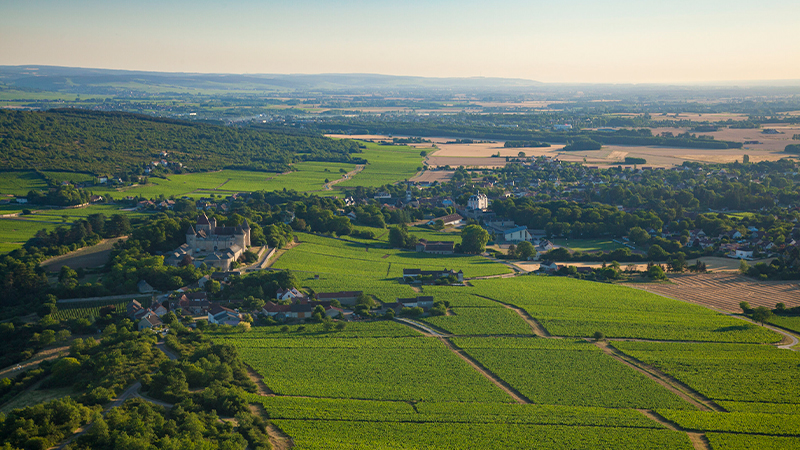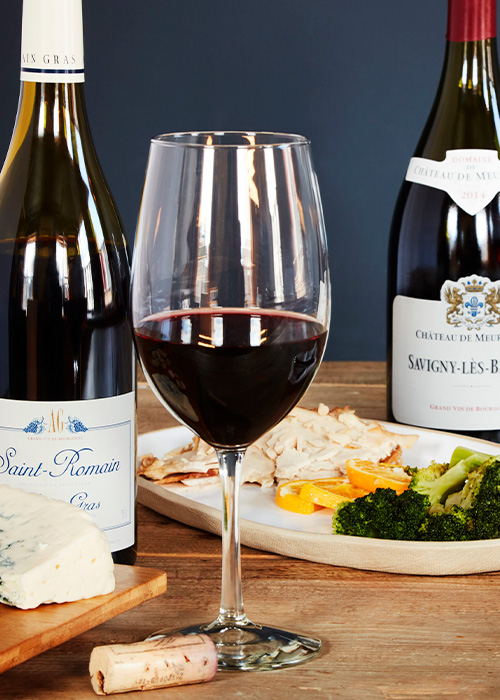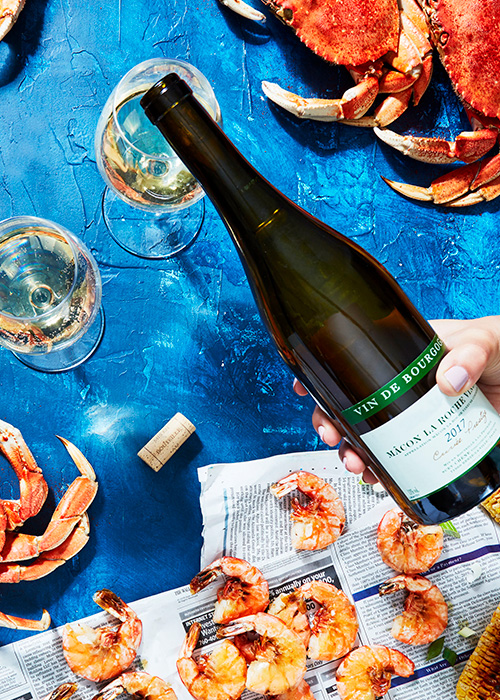
There’s a new (but also very old) French term to commit to memory. Don’t worry. It’s as easy to pronounce as “croissant,” and your reward for knowing it is quite possibly more delicious. It’s Bourgogne, pronounced “Boor-Goyn.” If the word looks familiar, that’s because it’s the French term for the region (and red and white wine) we call Burgundy in the States, typically at fancy restaurants where (ideally) someone else is paying.
But even if you’re familiar with “Burgundy,” it’s time to get to know “Bourgogne.” Really — the region of “Bourgogne” is actively reclaiming its original name, changing its branding all over the globe, and for good reason: “Burgundy” was an old shorthand that misrepresented an entire region, with a non-native word, no less. “Bourgogne” refers to (and encompasses) the whole beautiful (long) story of the winemaking region. That means a miraculously complex patchwork of highly regarded terroir coupled with nuanced winemaking traditions, and (most importantly) universally high standards for regional wine identity.
The best part for wine drinkers eager to get acquainted with the region, “Bourgogne” wines include a host of appellations that produce affordable wines that still share in the complexity of the region and the legacy of Bourgogne terroir. And all it takes to unlock that world of wine is a little geography lesson.

Historic Terroir
An elegant slice of territory in northern central France (with Chablis, also part of Bourgogne, hovering like a satellite region just to the northwest), Bourgogne is an incredibly dynamic winemaking region, bolstered by the renown of its star grapes, Chardonnay and Pinot Noir (grapes that just so happen to take on terroir like a canvas takes fine brush strokes).
Bourgogne’s history is a long one: The first vines were planted by invading Romans, while Benedictine monks began making wine at the Abbey of Cluny toward the end of the first millennium (909 A.D.). Cistercian monks first began to heavily identify wine with terroir about a hundred years later, and winemaking methods continued to be further refined over the next several centuries. As for the famous provenance of Chardonnay and Pinot Noir in the region, in 1395 the Duke of Burgundy, Philip the Bold, actually issued a decree banning the use of the Gamay grape.
Perhaps the most important thing about Bourgogne’s history as a region happened much, much earlier — 200 million years ago, give or take, when the entire region was under water. Well before it contained some of the world’s greatest winemaking territory, Bourgogne existed as the bottom of a shimmering turquoise sea, full of oysters, mussels, starfish, algae, and corals. When that otherworldly lagoon finally evaporated, its rich marine soils and crustaceans enriched the drying earth, creating the terroir that makes Bourgogne so famous — a mixture of marl, clay, and limestone.
Régionale AOCs in Bourgogne
Just like the incredible sea floor terroir can be found all over the region today, incredible bottles of Bourgogne wine can be found in all levels of regional production.
Granted, it’s easy to get intimidated by Bourgogne. It’s complexity in a petite package: The region is comparatively snug, but there are 84 appellations, plus countless vintages, historically designated Climats, and, of course, thousands of producers. To learn how to navigate the entire system of classification would require serious commitment, and heroic thirst. It never hurts to know a ton about something delicious, of course, but for someone looking to (affordably) explore Bourgogne, it’s unnecessary.
What you really need to know to get the best from Bourgogne is the universal commitment to terroir, from the literal ground up. And where Bourgogne terroir begins to assert itself is actually down at the base of its production pyramid, with the largest Régionale classification. Régionale Bourgogne takes up just over 50 percent of the overall production. There are seven appellations within the Régionale classification: Bourgogne, Bourgogne Aligoté, Bourgogne Mousseux, Bourgogne Passe-Tout-Grains, Coteaux Bourguignons, Crémant de Bourgogne, and Mâcon.
Going Deeper with Bourgogne-Plus and Mâcon-Plus
Within these seven appellations, two are actually able to get a bit more regionally specific (and your palate can follow right along with them): Bourgogne and Mâcon are two appellations that are both allowed to attach geographical designations to their names, i.e., “Bourgogne-plus” and “Mâcon-plus.” In practice that looks like a bottle of wine labelled “Bourgogne Côte Chalonnaise,” “Bourgogne Tonnerre,” “Bourgogne Hautes Côtes de Nuits,” or “Mâcon-Igé,” “Mâcon-Azé,” and “Mâcon-Lugny,” to name just a few.
As you might have guessed, in a Régionale wine, all the wine in the bottle comes from grapes grown in that region. And, in the case of the Bourgogne-plus and Mâcon-plus categories, all the wine comes from grapes grown in whichever geographic region is named on the bottle, such as Tonnerre, or Igé, or Azé, etc. The point isn’t to dizzy you with place names — there are no pop quizzes coming up, only popping corks. The point is introducing more specificity of terroir and production, which is at the heart and soul of what Bourgogne wine is all about.
There are clearly thousands and thousands of bottles to try within the seven Régionale appellations, but your best bet is starting within the Bourgogne-plus and Mâcon-plus categories themselves. You’ll get the same general price points as the other appellations but with more ability to call out specificities of terroir.
For instance, the Bourgogne Hautes Côtes de Beaune has very similar soil composition as the Côtes de Beaune (in the Côte d’Or, Bourgogne’s most prestigious terroir), but the vines are planted higher up (hence the “Hautes”), which means drainage is a bit more rapid and the wines end up a bit fresher and silkier — also exquisitely affordable. Bourgogne Tonnerre wines are 100 percent Chardonnay, made just 15 kilometers from Chablis and so expressing similar crisp maritime acidity, but they’re priced far more affordably.
For its part, wines from the Mâcon appellation uniquely benefit from being the southernmost of wines produced in Bourgogne — in fact, it’s almost like another side of what Bourgogne wine can be. With its roughly 80 percent whites (Chardonnay), the Mâcon AOC (and Mâcon-plus) offer a whole roster of white wines with varying levels of freshness, acidity, florals, a spectrum of fruits, richness, and even spice. And for red wines in the Mâconnais, you will actually find exceptional values in juicy red Gamay (which actually escaped Philip the Bold’s ruling at the time and enjoyed a happy home in southern conditions).
Bourgogne-plus designations really do bridge the gap between the basic Régionale and higher standards of production. A bottle of Bourgogne Côte Chalonnaise showcases the supple, light berries of a Pinot Noir with a brisker acidity, affordable at $40 but still sufficiently rich and red to pair with complex dishes such as exotically spiced pork or savory herbed game bird. (In fact if you’re looking to take your wine and food pairing game to the next level, Régionale appellations and the Bourgogne-plus and Mâcon-plus are worthy investments.)
The Impossible Value of Village Wines in Bourgogne

One step “higher up” on the Bourgogne production ladder is the Village category, with currently 44 Village-designated appellations. Inevitably, it gets complicated, but for a Village AOC wine in Bourgogne, a good rule of thumb is the wine in the bottle (almost always) comes from one village. The specifications for winemaking here are more rigorous, but not so much that the price skyrockets. An example of a Village AOC would be Fixin. Fixin enjoys a ton of the same elements of terroir as its more expensive neighbor, Gevrey-Chambertin, including rich clay and limestone in the soil. But because wines from Fixin are slightly lower down on the iconic sloping vineyards of the area, its wines are a bit more robust —chewier, chunkier, richly threaded heartiness with just a shade less nuance.
But that doesn’t mean they lack complexity. It does mean they’re markedly more affordable.
About 36 percent of total Bourgogne production is this kind of Village wine, and jumps to 47 percent when including Village Premier Cru. Some of them are better known, such as Nuits-Saint-Georges or Meursault, but if you really want to explore, look for any of the lesser-known Village AOCs, hidden gems such as Fixin, Rully, Irancy, Montagny, Saint-Véran, and Savigny-lès-Beaune, to name just a few.
Explore just a bit and you’ll find out that Irancy is very northwest within Bourgogne, not far from Chablis, but produces reds (as opposed to Chablis’ whites), specifically reds with pronounced minerality, florals, earth and textured fruit. Irancy wines often come from relatively young vines on extremely old soils overproducing and over-performing — richly expressive and surprisingly affordable.
Truly, a little research goes a long way. For instance, the village Rully exists in Bourgogne Côte Chalonnaise, where you’ll also find four other villages: Givry, Bouzeron, Montagny, and Mercurey. And while a village like Givry is slightly more famous, wines from Rully can deliver beautiful expressions of Pinot Noir and Chardonnay at $30 or $40 a bottle.
Time to Buy Bourgogne, What to Try?
Just being a bit better informed about a wine region makes us a lot braver with our wine-buying dollar. Now that you grasp the basics of Bourgogne, you’re equipped to try a few bottles. You can try any of the Bourgogne-plus or Mâcon-plus or you can drill deeper with a Village AOC. And, of course, once it’s time to really invest, you’ll head for Village Premier Cru, where all the grapes come from a specific plot in the village.
Whatever you buy, it’s all about research. What is this appellation known for? Its reds or its whites? Bear in mind, Bourgogne is associated with Pinot Noir but actually produces more Chardonnay. And while we associate whites with Chablis, there are incredible reds being made in Irancy just kilometers away. The new era of Bourgogne is about thinking outside the box and exploring what makes a region (and the region within the region) so special. Given the variety at play, you’ll have wine to pair with food through every season of the year.
With a little bit of calculating, really just a few notes in your phone, you can leave any wine store with an armful of the hidden gems from Bourgogne:
You might start with a Bourgogne Hautes Côtes de Beaune, or Bourgogne Hautes Côtes de Nuits, for that matter — the two main geographical denominations within Bourgogne’s illustrious Côte d’Or, where all of its bright and shiny Grand Cru live. The “Hautes” in the names sounds like the wines are more expensive, but it actually means the grapes are grown higher up on the slope, with a little less limestone, a bit more marlstone, and a bit faster drainage, all of which means slightly less complexity. But again, it’s only a matter of meters. Domaine Bertagna does Grand Cru in the Côte de Nuits. But for less than $30 you can buy a nimble, fruity, seductive Bourgogne Hautes Côtes de Nuits from the same producer, with cherry blossom and light berry and just a taste of chewy raisin skin hinting at the complexity of the larger terrain.
If you’re looking for white Bourgogne wine (and can’t afford this wallet-straining stunner), try a beautiful white wine from the Mâconnais (truly, if your summer 2022 isn’t stocked with it, we’ve failed you terribly). A bottle like Saint-Véran from Domaine de la Denante could easily become a go-to for summer barbecues and picnics, with subtle soft pear, toast, and nut flavors lending richness that can stand up to cheeses, cold chicken, marinated pressed tofu, and a world of other warm-weather foods that demand good drink.
If you want something slightly more substantial, look to Domaine Simon Bize et Fils. It does a Savigny-lès-Beaune Premier Cru, but a bottle of the non-Premier Cru runs you less than $50 and delivers a tender, weighty unctuous white wine made from Chardonnay with a slip of bracing acidity to keep it lithe.
That’s just a hint of the splendor of hidden gems waiting to be uncovered in Bourgogne. Look past the Grand Cru and the most famous Village Premier Cru to the Village and Régionale labels, and you’ll be rewarded with some of the most exquisite, unbelievable value bottle steals in all of French wine. Just don’t tell anyone else before you get a chance to brag.

This article is sponsored by Bourgogne Wines.